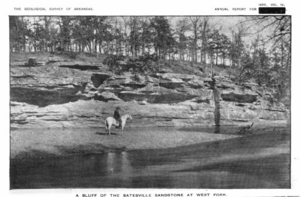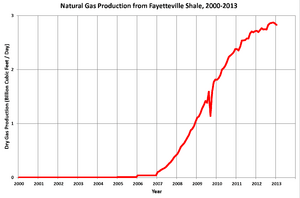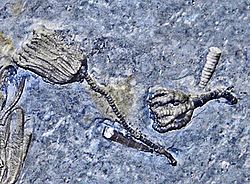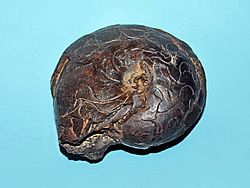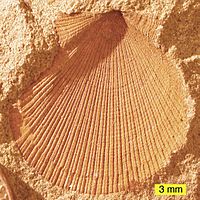Fayetteville Shale facts for kids
Quick facts for kids Fayetteville ShaleStratigraphic range: Carboniferous: Mississippian (Serpukhovian) |
|
|---|---|
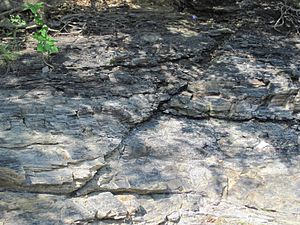
Outcrop of the lower Fayetteville Shale in northern Arkansas
|
|
| Type | Geological formation |
| Sub-units | Wedington Sandstone Member |
| Underlies | Pitkin Limestone, Hale Formation |
| Overlies | Ruddell Shale, Batesville Sandstone Moorefield Shale |
| Area | Arkansas and Oklahoma |
| Thickness | 50 to 500 feet (15 to 152 m) |
| Lithology | |
| Primary | Shale |
| Other | Sandstone, limestone |
| Location | |
| Region | Arkansas |
| Country | |
| Extent | 50 miles (80 km) |
| Type section | |
| Named for | Fayetteville, Washington County, Arkansas |
| Named by | Frederick Willard Simonds |
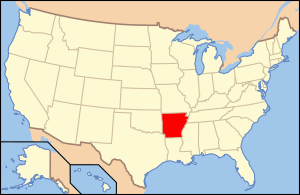 The Fayetteville formation runs widespread across Arkansas |
|
The Fayetteville Shale is a special type of rock found deep underground. It's a rock layer made of a fine-grained rock called shale. This rock layer formed a very long time ago, between 354 and 323 million years ago, during a period called the Mississippian Age.
You can find the Fayetteville Shale mainly in Arkansas and Oklahoma, in an area known as the Arkoma Basin. It's named after the city of Fayetteville, Arkansas. This shale is important because it holds natural gas. To get the gas out, a special process called hydraulic fracturing (or "fracking") is used.
Contents
How the Fayetteville Shale Got Its Name
A scientist named Frederick Willard Simonds first described this rock layer in 1891. He originally gave different names to parts of it. But by 1904, all these parts were grouped together and called the "Fayetteville Shale."
One part of the formation, which Simonds first called the Batesville Sandstone, is now known as the "Wedington Sandstone Member." It was likely named after Wedington Mountain.
Natural Gas in the Shale
The Fayetteville Shale contains natural gas trapped within its tiny rock spaces. To get this gas out, engineers use a method called hydraulic fracturing, or "fracking." This involves pumping water, sand, and chemicals into the rock to create tiny cracks, allowing the gas to flow out.
This process became more affordable and effective after many years of testing in other shale areas, like the Barnett Shale in North Texas. It works even better when combined with horizontal drilling, where wells are drilled sideways through the rock layer.
The first gas well in the Fayetteville Shale was drilled in July 2004 by Southwestern Energy Company in Conway County, Arkansas. In 2005, they drilled the first horizontal well there.
Experts from the US Energy Information Administration estimated that this shale area, which covers about 5,853 square miles (15,160 km2), held a huge amount of natural gas – about 13,240 billion cubic feet (375 billion cubic meters). Each well was expected to produce about 1.3 billion cubic feet of gas. However, by 2018, new drilling in the Fayetteville Shale had mostly stopped, and many wells were no longer in use.
Ancient Life in the Fayetteville Shale (Paleontology)
Paleontology is the study of ancient life, like dinosaurs and other creatures that lived long ago. Scientists have found many fossils in the Fayetteville Shale, which tell us about the plants and animals that lived there millions of years ago.
Most of the Fayetteville Shale formed in an ancient sea. This means that many of the plant fossils found in the black shale layers were likely washed into the sea from nearby land. However, one part of the formation, the Wedington Sandstone Member, was formed by ancient rivers. Plants found here were probably deposited closer to where they grew.
Ancient Plants (Flora)
Fossils of many ancient plants have been found. These include types of trees like Lepidodendron, which looked a bit like giant clubmosses, and various types of ferns and seed plants.
Ancient Animals (Fauna)
Many different kinds of ancient animals have been discovered in the Fayetteville Shale.
Ancient Fish (Vertebrates)
Scientists have found fossils of ancient fish, including types of sharks like Carcharopsis wortheni and other fish like Ozarcus mapesae.
Sea Lilies (Echinoderms)
Many fossils of crinoids (also known as sea lilies) have been found. These animals looked like plants but were actually marine animals related to starfish. Examples include Taxocrinus cestriensis.
Ancient Squid-like Creatures (Cephalopods)
Fossils of cephalopods are common. These were ancient sea creatures, similar to modern-day squid and octopuses, but many had shells. A well-known example is Goniatites granosus.
Corals
Ancient corals, like Amplexus expansus, have also been found. These were simple marine animals that often lived in colonies, building hard skeletons.
Clams and Mussels (Bivalves)
Many types of bivalves (animals with two shells, like clams and mussels) are preserved as fossils. One example is Aviculopecten squamula.
Brachiopods
Brachiopods are another type of shelled marine animal, similar to bivalves but with a different internal structure. Fossils like Inflatia gracilis have been found.
Snails (Gastropods)
Ancient gastropods, which are snail-like creatures, are also present in the fossil record of the Fayetteville Shale. An example is Platyceras subelegans.
Ancient Bugs (Arthropods)

Fossils of arthropods (like insects, spiders, and crustaceans) have been found. This includes trilobites, which were ancient sea creatures with segmented bodies, such as Paladin murconatus.
Tiny Crustaceans (Ostracods)
Ostracods are very small crustaceans, often called "seed shrimp," that lived in shells. Fossils like Cavellina have been identified.
Moss Animals (Bryozoans)
Bryozoans are tiny colonial animals that often look like moss or small fans. Many types have been found, including Archimedes communis, which had a unique screw-like shape.
Microscopic Organisms (Foraminifera)
Even tiny, single-celled organisms called foraminifera have left their microscopic shells as fossils in the Fayetteville Shale, such as Earlandia.


